Alter Festival – once is chance, twice is coincidence, third time is a pattern

Coverage of Alter Festival (August 24-26, 2023) by Martha Hviid, photos by Natalie Black and Martha Hviid
The Aarhus-based Festival Alter has existed for four years. Well, they had to cancel their first year due to that thing which we all remember, but that don’t have to mentioned here. Nevertheless, advertisements prior to this 2020-cancellation had already caught my eye. I’m awfully fond of the musician Klein from London, who was supposed to play in 2020, so anyone who books her has my immediate attention. Furthermore, the people behind Alter had invited Stockholm-based label Xkatedral, which I knew houses composer/sound artist Kali Malone, who I mostly know of because of her relationship with Stephen O’Malley from the experimental metal (experi’metal?) group Sunn O))), who I’ve met through mutual friends – and this is how it goes, right? We make these references and connections in our brains, and without much preparatory research our curiosity is piqued. Something connected to someone, connected to something that we like, trust or admire; surely this must be worth investigating too. For me this is the indication of any good festival; hand us a few keynotes in advance and then let the remaining web unfold in front of us while we’re there. Let us be surprised and moved in the moment. I’m not one for deep research if it’s at all avoidable. I love showing up with little to no expectations. It might come off as laziness but I assure you, sometimes it’s just a refreshing approach – especially if you’re an over-analyser by nature, or if you’ve been academised through years and years of school forcing you to check the footnotes.
Alter came back strong the two following years though. Aforementioned Kali Malone was invited back for a do-over, she brought her boo, Stephen O’Malley, and cellist Lucy Railton. Godfather of minimal techno Wolfgang Voigt came up from Cologne, as well as members of London-collective Curl, Tirzah and Coby Sey, the Mancunian wunder-group Space Africa, Russian (Ukraine-ally) Pavel Milyakov (aka Buttechno) and the legendary Ethiopian keyboardist Hailu Mergia.
Who and what forces were behind booking Alter? Slowly but surely, they were displaying an immensely interesting and progressive programming for a Danish festival of that size. Reaching peak-FOMO, this Copenhagener was overbooked, overworked and too broke to travel all the way to The City of Smiles. I could just about get over missing out on musical crushes Puyain Sanati, Xenia Xamanek, Abji_Hypersun, Pamela Angela, Clarissa Connelly, Astrid Sonne, Yrdloop x Blikfang, merely because they’re based in Denmark and I feel there might be other good chances to see them play, but it was clear that something special and unrepeatable was going on here, particularly through the concept of Samling, which was introduced as an Alter special – I will come back to this later.
Fast forward to this year.
Before this weekend, I think it’s been 6 years since my last trip to Aarhus. This is embarrassing because I have travelled many other places in this time frame, and even commuted to Odense for the past year, but somehow Aarhus feels physically and mentally very far away. I cringe from admitting this, and for someone based in Aarhus it probably sounds like it does to me when my friends who live on Nørrebro hesitate to come to Amager because “there’s a whole bridge between us”. Denmark is tiny. DSB tickets are expensive.
So, who is Alter made for? The day before leaving, my friend Agnete asked me the question, in different words but along the lines of “what will the audience be like? Is brilliant booking enough if the crowd is small or not receptive to the programme?” We had faith in the acts, but no sense of what the overall vibe and structure of Alter would be? Was it for a select insider crowd, living and organising things for each other in Aarhus? Would I, as an outsider to Aarhus, be able to navigate the layout and structure of not only the festival and the city, but also the social codes? Their website reassured me of the first two:
Is it possible to experience all performances, artworks, and concerts?
YES! There are no overlaps in the program of ALTER 2023. The festival moves between five locations that are all within walking distance.
I can’t give much of an account of what Thursday’s programme was like as I hadn’t arrived yet. So let’s finish Thursday’s remarks quickly. It took place at ARoS Art Museum. French/Egyptian group Le Cri du Caire replaced Irish band Lankum, Danish Bona Fide replaced Brits caroline (with a lowercase c). My friend who’s not on Instagram had missed the news of these replacements. Staying on top of what’s happening and going on during a festival is full on. Remember to bring a charged phone, and keep communication flowing. Aros Jagthornsskole and Hatis Noit from Japan played too. While all this was happening I was staying up too late at Copenhagen Distillery, where one of Alter’s headliners, yet another Curl-collective member, Brother May, played with new Danish shoegazey group Snuggle. Both played really excellent shows, but that’s not what I’m here to report on. Let’s move on to Friday.
Friday – Time travelling
I was lucky to have other friends attend the festival so it wouldn’t be a lonely experience. It was wonderful walking around, not having to navigate with my nose deep in Google Maps, but just connecting new parts of the city to the bits I knew already.
Starting out at Møntmestegården in Den Gamly By (The Old Town) felt like visiting a desolate film set. Walking down the small cobblestoned pavements, surrounded by old-fashioned shop displays, the scene was set before we even arrived at the venue. Møntmestegården used to house the upper class during the 17th century, with its chequered floor and baroque ceiling paintings.
We walked in, gathered around the allocated stage area – silence in the audience – and then, pow! Grev Trold shredded and growled his way through a long set of dense yet catchy black metal tunes. Full disclosure, I know Claus Haxholm who’s behind this moniker, but I was unprepared for – and thrilled by – being exposed to this project of his for the first time. Whatever dust was left from the 17th century was whirled up and swept out through the open windows, replaced by the mild August breeze and golden light from a slowmotion sunset coming in the other way.
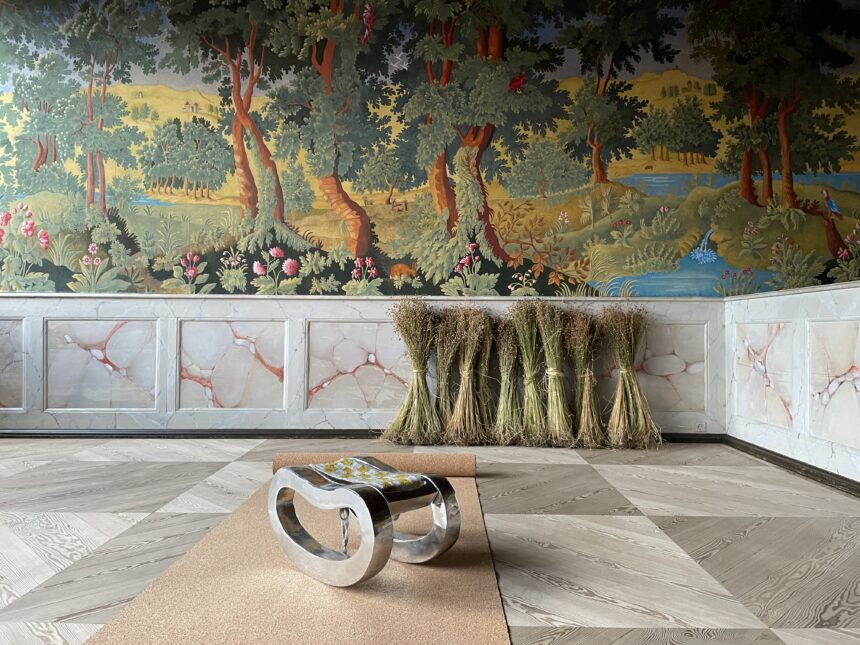
The intermission allowed for checking out Therese Bülow’s elegant art installation in the next room. A glistening rocking stool in metal on a yoga-like mat of cork, in front of 9 sheaves of flax leaning against the detailed mural (or was it tapestry?). I didn’t find any exhibition text explaining what I was supposed to intellectually extract from it, so it remained a sensory experience, which I was honestly pretty pleased about. Knowing how the flax must have rattled like tiny bells in transportation brought me right back to the Golden Age-style landscapes of farmed fields that I had seen from the train window on my way crossing the country a few hours earlier.
It made me wonder what my life would have been like if my own dad had passed on his mother’s folk roots instead of choosing the political hippie-rock route.
The break was over and folk-legend Frode Veddinge entertained us the way a classic entertainer does. The jokes were warm and risqué in that old-timey way, the songs were comforting and, particularly because of back-up singers Thilde Vegenfeldt and Clarissa Connelly, just a very, very sweet experience. It made me wonder what my life would have been like if my own dad had passed on his mother’s folk roots instead of choosing the political hippie-rock route. Oh well, on to Voxhall.
First act Moin was very good. Somehow so good that it turned a little boring for me – maybe I’m not so infatuated with technical precision (which Moin has in bucketfuls), maybe my attention span just needed a break. I popped out for a second to find a friend who had just arrived. Before I knew of it I had been outside for a while and remembered I was supposed to get back in to see who and what was playing. Moin was over and the next band had already gone on stage.
Crack Cloud carried themselves with a high-strung energy, oscillating between erratic mannerisms, seeming almost possessed by something outside of themselves, whilst simultaneously being in utter control.
Many references came to mind when, a little late, I returned inside for the Crack Cloud concert, knowing nothing in advance. The band carried themselves with a high-strung energy, oscillating between erratic mannerisms, seeming almost possessed by something outside of themselves, whilst simultaneously being in utter control. Especially their seriously charismatic drummer/lead-singer seemed so attuned to not only his own position but with caring eyes for the entire band and situation. It was kind of endearing.
Suddenly I felt my teenage heart swell in my chest. I decided to google them for a bit of context, and came across both Mad Max and Lost Boys references. But what came to my mind was The Tribe, a tv-series from New Zealand that enveloped the millennium and my early adolescence. Oddly their music also made me think of the band Girls Pissing on Girls Pissing, which hails from the very same country as The Tribe. As Crack Cloud kept playing in front of me, and as I kept reading on my phone, I found out that they actually come from Vancouver, which made my tween/teen heart take a leap straight into my early twenties, where love brought me to Canada (more specifically Toronto) and where I found myself surrounded by bands and creative projects that introduced me to post-punk and no wave references such as The Pop Group, Gang of Four, The Fall and The Homosexuals. Just like the people I befriended in Canada, Crack Cloud was tight and wild and something rare, kind of like when Synd og Skam first came over from Svendborg and kicked all us Copenhageners in the head.
This evening they were wrapped in Dannebrog flags, twirling and taking the floor with the rest of us instead of staying raised above us on stage.
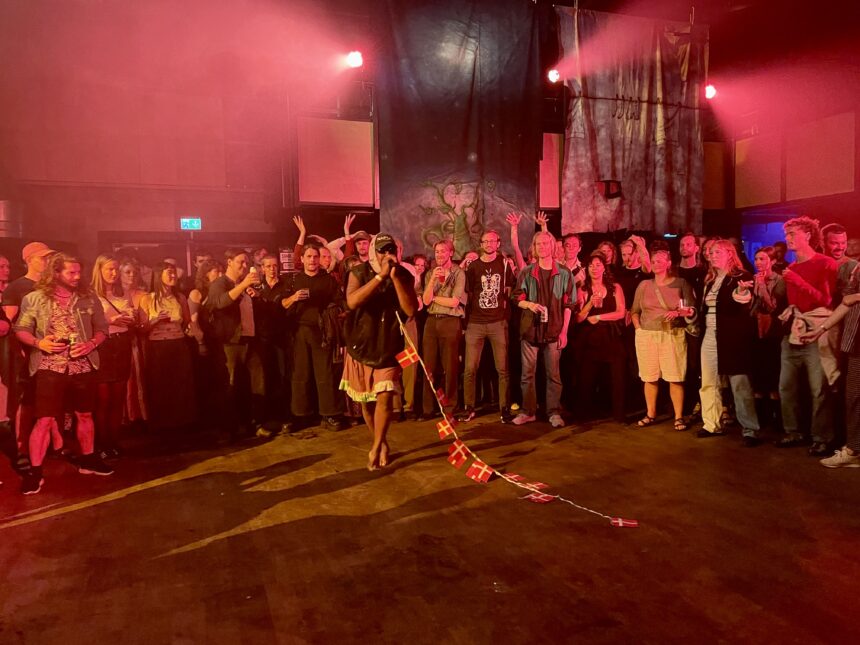
Mykki Blanco was up next, and we were summoned by a heavy and repetitive beat blasted from the stage. Everyone huddled up for the best view, and soon after the star themself propelled in, as if from a small astral explosion. This evening they were wrapped in Dannebrog flags, twirling and taking the floor with the rest of us instead of staying raised above us on stage. I won’t bite the flag-bait here. Who even knows what that was about? They did however tell us they’d been in Aarhus all week, and seemed quite happy and content by the serene and mellow time they’d spent “drinking lots of water and relaxing in the park”. They also shared the news that this was their last festival of the summer since they were headed to grad school. Mykki Blanco is doing a Master’s degree. Which school and subject I don’t know but this evening was dedicated to “compassion and togetherness”. You can’t really argue with that.
Straight on from Mykki Blanco’s banger parade Lyra Valenza kept the party going in a more techno-like fashion. People were warmed up for dancing and trancing. My feet were tired, and the prior night’s late bedtime was catching up with me. Though I wasn’t in the middle of the floor shuffling my feet and punching my fists in the air, the whole situation somehow served as a perfect hypnotic backdrop for drowsy hallucinations, as a result of my sleep deprivation from the night before. I remember thinking how tight Lyra Valenza’s execution was. It seemed they had a telepathic connection with each other and were navigating the blue-lit darkness with what must have been some sort of sonar-based expertise, because the rest of us couldn’t see much. The next day I met one of them in passing, and he stated that they “had just been doing this for a very long time”. It was one of those mesmerising and surreal concerts that afterwards feels like something that might as well have happened in a dream.
Saturday – Gather round
Saturday at 15:30 (/3.30PM) Peter Scherrebeck aka Misty Superdeluxe got married at the art venue iovermorgen. It was an intimate and charming ceremony featuring singing, dancing, a speech, a decked out motorcycle (for arrival and departure), rose petals, smoke and a ghost in wolf slippers. Through a relatively simple feedback system consisting of an iPhone on call with the PA system, a scratchy and haunting sound patina underlined the whole thing. Misty’s voice was silky smooth and delivered with a very pleasant tonality. By the time Misty and the ghost took off into the streets of Aarhus, everyone was cheering for both them and for love.
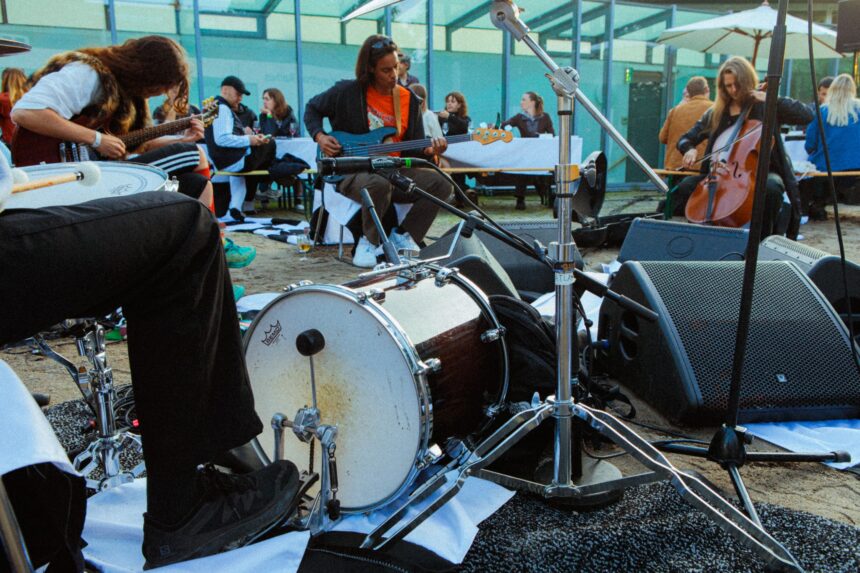
This day felt as if it had many chapters to it. Remember how I told you to bring a charged phone? Staying on top of logistics is key. Alter’s third instalment of Samling took place at Aarhus Kunsthal, over the course of a dinner put together by food and wine guys Magnus Malmros and Emil Olander. Samling is a site-specific grouping of musicians performing a piece made specifically for the festival. First year, it was 6 drummers while it was 6 guitarists the following year – which brings us up to this year’s version of Samling.
The whole thing was set up as an outdoors circular formation of tables, with the 20_14 supergroup Clarissa Connelly, Cæcilie Trier (CTM), Emil Elg (Synd og Skam, LOL Beslutning), Henriette Motzfeldt (Smerz), Mija Milovic and Rune Kielsgaard (I Got You On Tape, School of X and more), in the middle. Chequered banners stretched out from the performers to the dinner guests, like a connecting tablecloth, visually drawing our attention towards the centre.
The soundscape that Samling created was improvisational, unstructured; wavy at times, clunky at others.
Those of us who weren’t eating were free to roam the Kunsthal, both the surrounding outdoors area and the exhibitions inside. The soundscape that Samling created was improvisational, unstructured; wavy at times, clunky at others. It wasn’t a 1-2-3-4 experience, it was rather another flavour profile to the meal. I’m not sure I would want to listen to it recorded in its entirety, but together with the elements of passing traffic, various food smells and the atmosphere of happy humans coming together, it was a proper immersive Gesamtkunstwerk.
Once the dinner performance was over, the seated groups quickly dissolved. They were rushing over to see the Norwegian saxophonist and breathwork master Bendik Giske open Voxhall’s line-up for the night.
I can not say a single bad thing about Bendik Giske. He’s honestly extremely impressive, and carried himself with grace, both on stage and through the crowd later that night. His music works on a transcending level, flowing directly from song to song. The audience seemed completely captivated, and for the duration of the concert time felt suspended. For me it was hard watching his technique without inadvertently holding my own breath though, and I was running out of oxygen. It reminded me of what it was like watching the 80’s alien sci-fi film The Abyss, which mostly takes place under water. It also happens when I sleep next to someone who’s snoring. Is over-empathetic breathing patterns a thing? Bendik, your music is wonderful, I’m practising being a better audience though, and maybe holding my breath for longer.
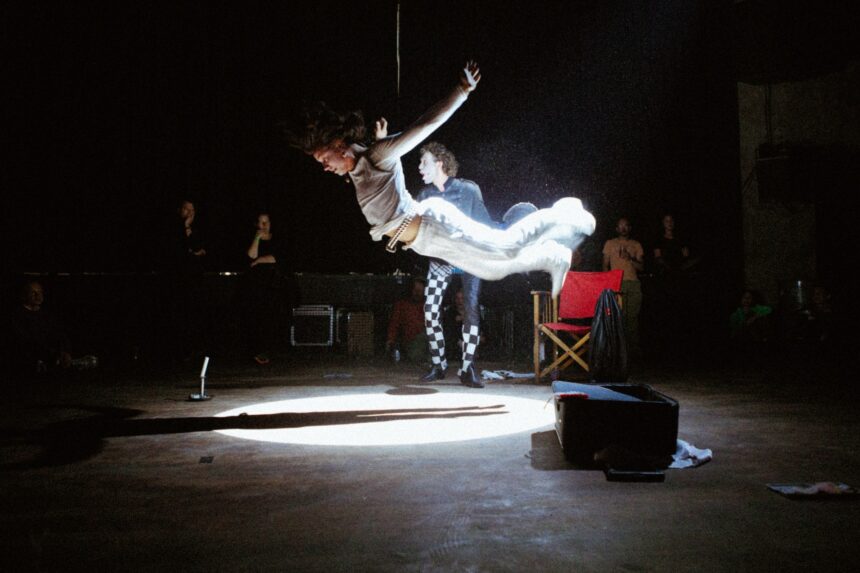
What a privilege to get a bit of theatre in the middle of a predominantly music-centred festival.
Earlier, at Samling I briefly met multi-artist Skjold Rambow. As a teaser he told me that the performance he had planned for later would be a little intermission/intervention in the music programming. I didn’t know what this meant, but when time came I was ready for something exactly like that. It turned out to be an ambitious and lengthy meta-commentary on theatre (performance) and the performer’s role in it. Made up in a white clown-fashion, in sailor hat, long skirt and facepaint, Rambow was supported on stage by Sofie Fæste and Rasmus Balling. The lines of the play were poignant, well-delivered and the physical elements circus-like. The background music bits by CTM, ZULI and Croatian Amor were proportionally spread out over the course of the whole performance. What a privilege to get a bit of theatre in the middle of a predominantly music-centred festival.
It seemed that everyone was a little extra excited for Caterina Barbieri that night. I’ll admit, she is very cool. She even brought her own light guy and a bionic-looking arm-armour. The music, the visuals, it was beautiful. Unfortunately I had one of those zone-out moments again and didn’t really connect with the show. Perhaps you can tell from the mass of text so far, but this was a marathon. So I sat it out on the side-lines for a bit. Drank some water and looked at the spectacle of humans lumping around and swaying to the music.
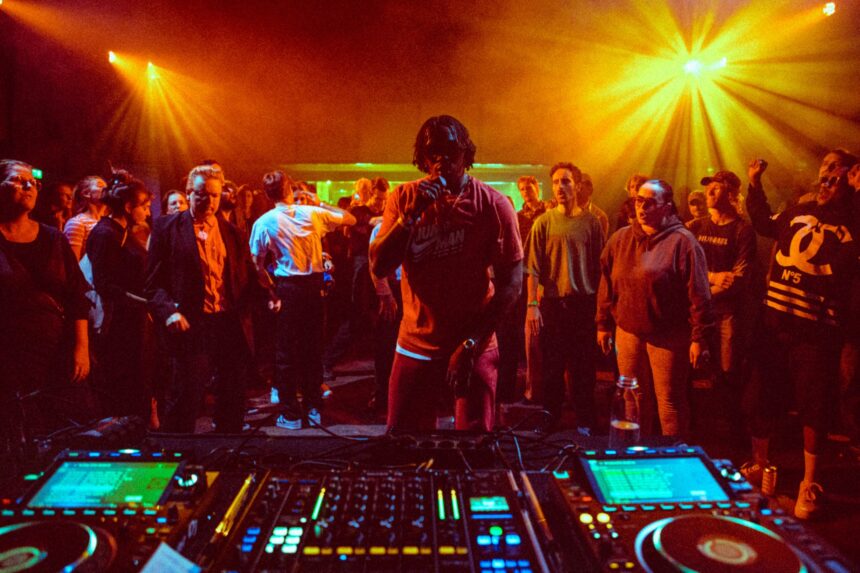
I’ve seen Brother May charm his crowds before, but this was a level up.
As previously mentioned I saw Brother May play in Copenhagen two days before. He’s a dear pal, so suffice to say that I’m pretty biassed. At Alter he played the older hits as well as songs from his new album “Pattern with Force”, which he co-produced with the musical mastermind Mica Levi, so what’s not to love? But instead of talking a lot about Brother May here I’d rather turn my attention to the crowd – the Aarhus/Alter crowd that Agnete and I curiously pre-speculated about on Thursday night (plus earlier in the text here). Because this is where I think a real festival stands its test. How does the crowd receive and interact with the show in front of them? I have to say, the Copenhagen crowd was good – the Aarhus crowd was brilliant. The call and response during “Demanding Love”, which Brother May prompted early on in the set, acted as a bit of a warm-up, but slowly the audience picked it up and took it further. There was dancing, arm-wagging, bouncing and hugging. I’m not sure how many were familiar with his repertoire before the show, but by the time the ultra catchy “Money Counts Money” came around, the loving atmosphere turned into a full-blown group project, with everyone encircling Brother May on the floor and even freestyling some spontaneous synchronised footwork. I’ve seen Brother May charm his crowds before, but this was a level up.
Loraine James closed the ball. With an intensity in her eyes that could be ascribed to either perfectionism or nerves (or both), the energy between her and the audience wasn’t as osmotic as the previous act, but the crowd didn’t seem to mind. They were ready to dance, and so we did. Loraine James delivered everything we needed in that moment, and like after a good multiple-course meal everyone seemed satiated and happy to leave at the end of it. Alter had done its job. Smiles all around (just like the city slogan promised us).
Info: Martha is a Copenhagen-based visual artist, who for years also worked as a concert promoter and later hosted a radio show on The Lake Radio (DK) as well as doing guest appearances on NTS Radio (UK) and The Other Radio (ZA). Claus Haxholm, who performed as Grev Trold, also writes for P/A. The editor-in-chief of P/A works with Lyra Valenza, but hasn’t been involved in any decisions regarding which concerts to highlight in this article.